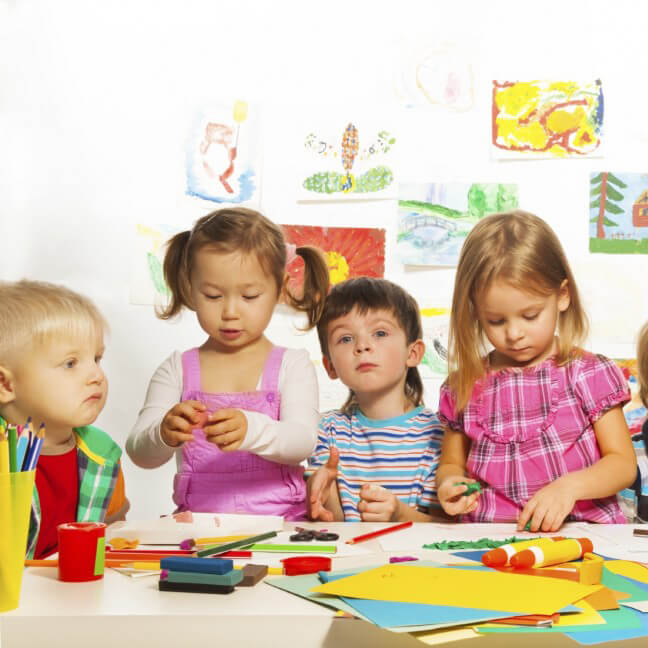Developmental Milestones for Infants
From the moment a baby is born, they are developing skills and connections that help them understand the world around them. This article explains what you can expect during that exciting first year.
From the moment a baby is born, they are developing skills and connections that help them understand the world around them. This article explains what you can expect during that exciting first year.
 The first year with baby is filled with wonder
The first year with baby is filled with wonderIsn’t it remarkable that hospitals send helpless babies home with parents who have neither a clue nor an instruction manual? Oh, the worries that have plagued this mama’s mind since day one with my babies: Are they healthy? Are they on track? Am I doing enough? Too much? Am I even doing it right? You’ve likely heard the saying “Behind every great kid is a mom who’s pretty sure she’s screwing it all up.” (Preach, author unknown!)
Luckily, most parents get the hang of it before too long. And thankfully, there are some great resources that parents and pediatricians can use to help gauge whether children are progressing on schedule, and to intervene early if there are delays.
 Jane Squires, Ph.D., is an expert in early childhood development and early identification of delays. She stresses the importance of involving parents in the monitoring of young children’s development. After all, who knows the child better? Squires is lead author of the Ages & Stages Questionnaires®, Third Edition (ASQ®-3). ASQ-3 is often used by pediatricians and child care centers, in conjunction with parents and caregivers, to screen young children for developmental delays.
Jane Squires, Ph.D., is an expert in early childhood development and early identification of delays. She stresses the importance of involving parents in the monitoring of young children’s development. After all, who knows the child better? Squires is lead author of the Ages & Stages Questionnaires®, Third Edition (ASQ®-3). ASQ-3 is often used by pediatricians and child care centers, in conjunction with parents and caregivers, to screen young children for developmental delays.
What sorts of developmental milestones should parents notice, when it comes to typically developing infants during the first year? The Centers for Disease Control (CDC) gives us a breakdown on some noteworthy behaviors for most babies.
In the event that delays are suspected, don’t panic! Early intervention is key. Identifying possible delays early gets you on the path to getting the supports in place to help your child achieve better outcomes. Discuss your child’s development and any concerns with your pediatrician. They’ll have lots of advice, as well as referral options for you to pursue additional resources if needed. You can also do some homework online. There are some great websites referenced at the end of this column and on the agesandstagesresearch.com webpage under parent resources.

Quality parent–child interaction makes a tremendous difference in supporting healthy development. Get down on the floor and play! Read to them. Cuddle. Make things together. Go places. Explore and identify new things. Narrate the trip through the grocery store aisles. Talk and sing. Make it a priority to be present and engaging. “It’s the most important thing that parents can do for their children,” says Squires.
Squires suggests some simple activities parents can try with their children:
With babies 1–4 months of age:
With babies 4–8 months of age:
With babies 8–12 months of age:
With babies 12–16 months of age:
 Parents have an opportunity to try an ASQ developmental screener for free online anytime at www.discoverasqstudy.com (no obligations; and no personal names or addresses are collected). Each questionnaire takes about 10–15 minutes to complete. Answer based on your observations of your child in natural environments, looking at communication, gross motor, fine motor, problem solving, and personal-social skills. You can see a copy of your child’s screening results by email and/or download at end of the session, and get targeted play and learning activities that fit your child’s age, as well as suggested resources if you have concerns about risk for delay.
Parents have an opportunity to try an ASQ developmental screener for free online anytime at www.discoverasqstudy.com (no obligations; and no personal names or addresses are collected). Each questionnaire takes about 10–15 minutes to complete. Answer based on your observations of your child in natural environments, looking at communication, gross motor, fine motor, problem solving, and personal-social skills. You can see a copy of your child’s screening results by email and/or download at end of the session, and get targeted play and learning activities that fit your child’s age, as well as suggested resources if you have concerns about risk for delay.
Another saying I’ve heard is “worry doesn’t take away tomorrows troubles, it takes away today’s peace” (Randy Armstrong). Easier said than done, no doubt. But when parents can get a little encouragement in feeling more competent and confident in their caregiver roles, and when children can get additional support in reaching important milestones, it does help quiet the worries. Peace be with you, mama. You’ve got this!
Additional resources for parents:
Ages & Stages Questionnaires
www.agesandstages.com
www.discoverasqstudy.com
Centers for Disease Control and Prevention
www.cdc.gov/ncbddd/actearly/milestones
www.cdc.gov/ncbddd/childdevelopment/positiveparenting/toddlers.html
https://www.cdc.gov/ncbddd/actearly/concerned.html
American Academy of Pediatrics
https://www.healthychildren.org/english/ages-stages/baby

“ASQ-3 has helped make our staff and our families more aware of developmentally appropriate growth and development. The resources that come with the ASQ-3 have been instrumental for parents to provide school readiness activities at home and to understand the objectives that we cover in our plans.”
Jessica Trail, Head of Faculty & Administration, The Young School